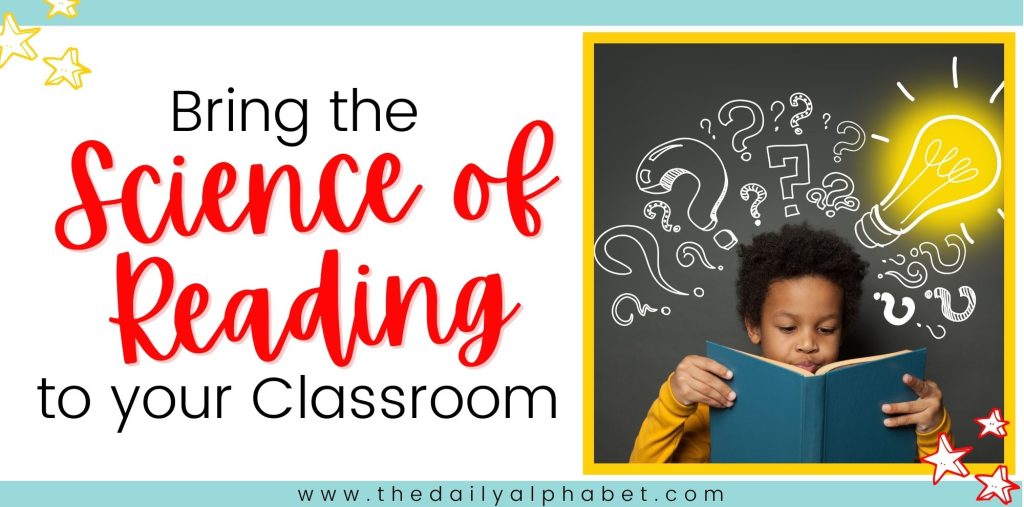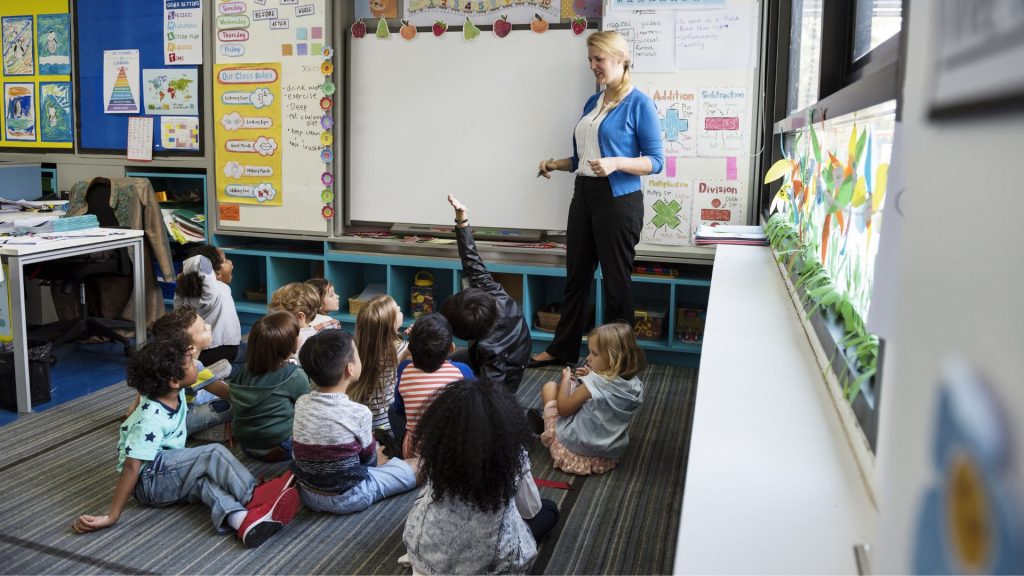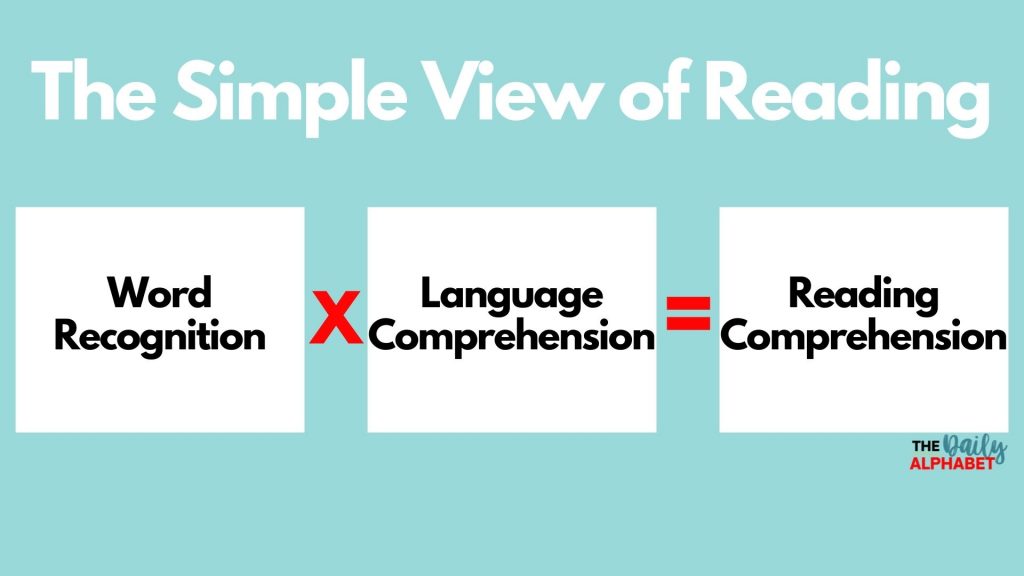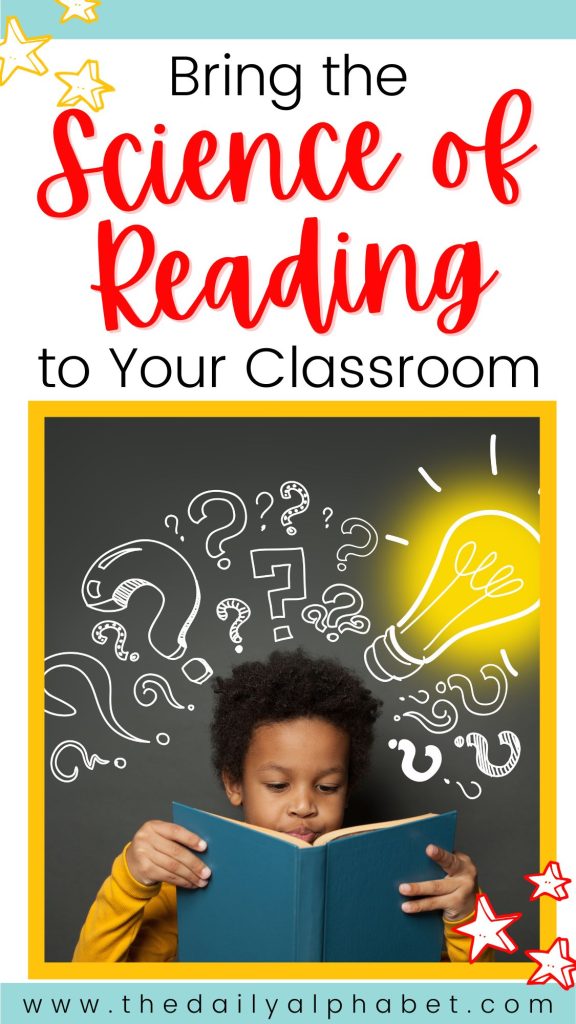
“The Science of Reading” isn’t just a trendy phrase in education; it’s the key to unlocking the doors to proficient reading. It’s not a curriculum or just an educational philosophy but a collection of meticulously researched insights into how reading works. In a world where reading skills are critical, understanding the science behind it is the essential first step.
Today, we’ll explore what the Science of Reading truly is and how you can bring it into your classroom. Whether you’re a veteran teacher, a fresh face in the world of education, or just someone curious about improving literacy, this blog post is here to guide you on the path to building strong readers!
But what is the Science of Reading exactly? How can you apply it in your classroom? And what about phonemic awareness skills, reading fluency, and decoding strategies? We’ll address all of these questions and more. So, let’s set our course to understand and embrace the Science of Reading, and together, we’ll empower our students with the gift of literacy.
This post contains affiliate links. You can take a peek at my disclosure here.
What is the Science of Reading?
The term “Science of Reading” might sound complex, but at its heart, it’s a way of understanding how reading works. It’s not a specific set of rules or a ready-made curriculum. Instead, it’s like a deep dive into the science behind reading.
Scientists and experts have been studying how our brains read for many years, and the Science of Reading is all about using their discoveries to help us become better readers. Think of it as a roadmap that guides educators in teaching reading effectively. It’s not about forcing every student to learn the same way but tailoring teaching to fit their unique needs.
Reading isn’t just one skill; it’s a mix of many, like understanding letter sounds, putting them together to make words, reading smoothly, knowing the meanings of words, and grasping the story. The Science of Reading gives teachers the tools to adjust their teaching methods to ensure every student can become a great reader, no matter how they learn best.

How to Bring the Science of Reading to Your Classroom
Since the Science of Reading isn’t a pre-packaged curriculum that you can implement, you might be wondering how to apply its principles in your classroom effectively. The answer lies in understanding that the Science of Reading is more like a compass than a map—it provides direction. Still, you must tailor your approach to suit your students and teaching style.
To bring the Science of Reading into your classroom, you can start by focusing on evidence-based practices. These practices are like well-tested techniques proven to help students become better readers. For instance, one essential component is systematic phonics instruction. This means teaching students how to connect the sounds of letters with the letters themselves. By starting with simple letter-sound relationships and progressing to more complex ones, you give your students a strong foundation for reading.
Additionally, pay attention to assessment and differentiation. This means regularly checking how well your students are doing with their reading and adjusting your teaching based on their needs. It’s like a personalized approach to learning. For those students who need extra support, you can provide additional help in specific areas. On the other hand, for those who are more advanced, you can offer more challenging material. In essence, the Science of Reading is about adapting your teaching methods to suit the unique needs of your students, helping each one to become a proficient and confident reader.
Phonics
Phonics is an integral component of the Science of Reading, and it plays a pivotal role in helping little learners unlock the world of words. Phonics instruction involves teaching students the relationships between letters and their corresponding sounds. By understanding these connections, students can decode words (we’ll talk more about decoding below) and read with greater fluency and comprehension. While the Science of Reading encompasses a wide range of literacy concepts, phonics remains a cornerstone, and it’s an area where you can make a significant impact in your classroom.
Effective phonics instruction involves introducing students to letter-sound relationships in a systematic and structured manner. Starting with letter recognition and the sounds they represent, teachers can progress to more complex concepts like word families, consonant blends, and vowel combinations.
Engaging activities such as phonics word games and worksheets, and interactive exercises can help reinforce these concepts in a fun and meaningful way. By implementing a structured phonics program, you give your students the building blocks they need to become confident and proficient readers.
A great book to read about phonics comes from Wiley Blevins, titled A Fresh Look at Phonics: Common Causes of Failure and 7 Ingredients for Success. This book is an absolute game-changer when it comes to teaching phonics!
Phonological Awareness and Decoding
In this section, we will explore two essential aspects of reading: phonological awareness and decoding. Let’s break these down into simpler terms.
Phonological awareness refers to the ability to identify and manipulate the individual sounds, or phonemes, in spoken language. Decoding, on the other hand, is the process of translating written text into spoken language by applying one’s knowledge of letter-sound relationships, and it falls under phonics. You can learn more about the difference between phonological awareness and phonics here. Understanding how these two concepts intertwine is fundamental to nurturing strong readers in your classroom.
Phonological awareness lays the foundation for decoding. By engaging students in activities that develop this awareness, such as syllables, identifying beginning and ending sounds in words, and more, you’re preparing them to decode written language effectively. For example, when a child can recognize that the word “bat” can be broken down into the sounds /b/, /a/, and /t/, they are better equipped to sound out words during reading. Students can then move into phonemic awareness, a type of phonological awareness that focuses more specifically on individual phonemes or sounds rather than larger chunks of words. It’s in these early stages of language development that phonological awareness takes root, setting the stage for successful decoding and reading fluency.

For more on phonological awareness and all of the instructional vocabulary that goes with it, you can grab this free Phonological Awareness Cheat Sheet.
Decoding, as the practical application of phonological awareness, involves recognizing letter-sound relationships and blending these sounds together to form words. More simply put, it is translating print to speech. It’s the bridge that connects printed text to the spoken word. By guiding them through the process of recognizing letter patterns and practicing phonics, you empower them to tackle unfamiliar words with confidence and comprehension. Together, phonological awareness and decoding form the dynamic duo that empowers young learners to unlock the world of reading.
Reading Comprehension
The goal of literacy instruction is reading comprehension, as stated in the simple view of reading. This is where students not only decode words but also understand and interpret the meaning behind the text. It’s the point where reading transforms from a mechanical process into a meaningful and enriching experience.

In order to nurture reading comprehension, it’s essential to teach your students a set of strategies that help them engage with the text on a deeper level. These strategies can include making predictions, asking questions, summarizing, and making connections to their own experiences. Encourage your students to think critically about what they read, to visualize the story, and to relate it to their lives.
These techniques help students to understand the text deeply, connect with it, and enjoy reading even more. So, reading comprehension isn’t just about reading words; it’s about reading for meaning and enjoyment. It’s like turning a black-and-white book into a colorful movie in the mind.
By cultivating these skills, you empower your students to become active readers who interact with the text rather than passively decoding words. Additionally, providing a rich and diverse range of reading materials, from picture books to informational texts, ensures that your students have the opportunity to practice these strategies in various contexts, further enhancing their reading comprehension abilities.
Reading Fluency
Reading fluency is a necessary component of the literacy puzzle. It’s the bridge between decoding words and understanding the text. It plays a significant role in a student’s ability to read with confidence and expressiveness.
Reading fluency is not just about reading quickly; it’s about reading with accuracy, appropriate pacing, and expression. To help your students develop fluency, you can employ strategies like repeated readings. Encourage them to read the same passage multiple times, gradually increasing their speed and expression. By revisiting the text, students become more familiar with it. They can focus on infusing emotion and intonation into their reading. Furthermore, it’s beneficial to provide various reading materials, including books and passages at different difficulty levels. This diversity enables students to practice fluency with texts that suit their skill levels, helping them progress at their own pace.
Reading aloud to the class with expression, pausing at punctuation, and emphasizing the flow of language can be a powerful example. Additionally, you can incorporate technology, such as audiobooks, to expose your students to fluent reading models. A listening center during small groups and centers is the perfect place for this activity. This can be particularly helpful for struggling readers, providing them with a clear and confident model to mimic. By prioritizing reading fluency in your classroom, you’re not only enhancing your students’ reading abilities but also instilling in them a love for reading that will help them well throughout their lives.
The Science of Reading is not a one-size-fits-all solution; it’s a compass guiding educators toward evidence-based practices. As teachers, we have to continually adapt, engage in professional development, and create an environment where every student has the opportunity to master the art of reading. If you’re not sure where to begin, or you just need a refresher, then I highly recommend Lindsay Kemeny’s book 7 Mighty Moves: Research-Backed, Classroom-Tested Strategies to Ensure K-to-3 Reading Success (The Science of Reading in Practice).
Remember, the Science of Reading isn’t a destination; it’s a journey towards nurturing strong readers and fostering a lifelong love for the written word. By understanding and applying its principles, we can transform our classrooms into places where the magic of literacy unfolds, one page at a time.













